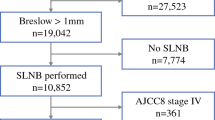Abstract
Management of patients with cutaneous melanoma in the absence of lymph node metastases is still controversial. The experience at the National Cancer Institute in Naples was analyzed to evaluate 3-year disease-free survival and overall survival for all patients who underwent sentinel lymph node biopsy (SLB) with Breslow thickness greater than 4 mm. Data from 359 sentinel biopsies performed in the past 5 years were reviewed to determine the effect of the treatment on disease-free survival and overall survival after stratifying patients for node status, tumor ulceration, and Breslow thickness. Statistical analysis showed a better 3-year survival for sentinel node-negative patients than for sentinel node-positive cases (88.4% and 72.9%, respectively;P<.05). Tumor ulceration retained its prognostic significance despite lymph node status, indicating a higher risk for development of distant metastases. Survival curves associated with thicker melanomas did not show significant differences between negative- and positive-SLB patients. SLB provides accurate staging of nodal status in melanoma patients who have no clinical evidence of metastases. Longer follow-up and final results from ongoing trials are necessary to definitively clarify the role of this procedure.
Similar content being viewed by others
References
Gershenwald JE, Mansfield PF, Lee EJ, et al. Role for lymphatic mapping and sentinel lymph node biopsy in patients with thick (>4mm) primary melanoma.Ann Surg Oncol 2000;7:160–5.
Kim S, Garcia C, Rodriguez J, et al. Prognosis of thick cutaneous melanoma.J Am Coll Surg 1999;188:241–7.
Morton DL, Wen DR, Wong JH, et al. Technical details of intraoperative lymphatic mapping for early stage melanoma.Arch Surg 1992;127:3923–9.
Dessureault S, Soong SJ, Ross MI, et al. Improved staging of node negative patients with intermediate to thick melanomas (>1mm) with the use of lymphatic mapping and sentinel lymph node biopsy.Ann Surg Oncol 2001;8:766–70.
Shen P, Guenther JM, Wenek LA, et al. Can elective lymph node dissection decrease the frequency and mortality rate of late melanoma recurrences?Ann Surg Oncol 2000;7:114–9.
Caracò C, Chiofalo MG, Niro J, et al. Sentinel lymph node biopsy to stage patient with cutaneous melanoma at the National Cancer Institute of Naples.Tumori 2002;88:S12.
Thompson JF. The Sydney Melanoma Unit experience of sentinel lymphadenectomy for melanoma.Ann Surg Oncol 2001;8:44–7.
Morton DL, Thompson JF, Essner R, et al. Validation of the accuracy of intraoperative lymphatic mapping and sentinel lymph-adenectomy for early stage melanoma.Ann Surg 1999;230:453–65.
Clary BM, Brady MS, Lewis JJ, et al. Sentinel lymph node biopsy in the management of patients with primary cutaneous melanoma: review of a large single-institutional experience with an emphasis on recurrence.Ann Surg 2001;233:250–8.
White RR, Stanley WE, Johnson JL, et al. Long-term survival in 2505 patients with melanoma with regional lymph node metastasis.Ann Surg 2002;235:879–87.
Essner R, Chung MH, Bleicher R, et al. Prognostic implications of thick (>4 mm) melanoma in era of intraoperative lymphatic mapping and sentinel lymphadenectomy.Ann Surg Oncol 2002;9:754–61.
Ferrone CR, Panageas KS, Busam K, et al. Multivariate prognostic model for patients with thick cutaneous melanoma: importance of sentinel node status.Ann Surg Oncol 2002;9:637–45.
Massi D, Borgognini L, Franchi A, et al. Thick cutaneous melanoma: a reappraisal of prognostic factors.Melanoma Res 2000;10: 153–64.
Chung MH, Gupta RK, Essner R, et al. Serum TA90 immune complex assay can predict outcome after resection of thick (>4 mm) primary melanoma and sentinel lymphadenectomy,Ann Surg Oncol 2002;9:120–6.
Thompson JF, Shaw HM. The prognosis of patients with thick primary melanomas: is regional lymph node status relevant, and does removing positive regional nodes influence the outcome.Ann Surg Oncol 2002;9:719–22.
McMaster KM, Reintgen DS, Ross MI. Sentinel lymph node biopsy for melanoma: controversy despite widespread agreement.J Clin Oncol 2001;19:2851–5.
Author information
Authors and Affiliations
Corresponding author
Rights and permissions
About this article
Cite this article
Caracò, C., Celentano, E., Lastoria, S. et al. Sentinel lymph node biopsy does not change melanoma-specific survival among patients with breslow thickness greater than four millimeters. Annals of Surgical Oncology 11 (Suppl 3), 198S–202S (2004). https://doi.org/10.1007/BF02523628
Received:
Accepted:
Issue Date:
DOI: https://doi.org/10.1007/BF02523628




